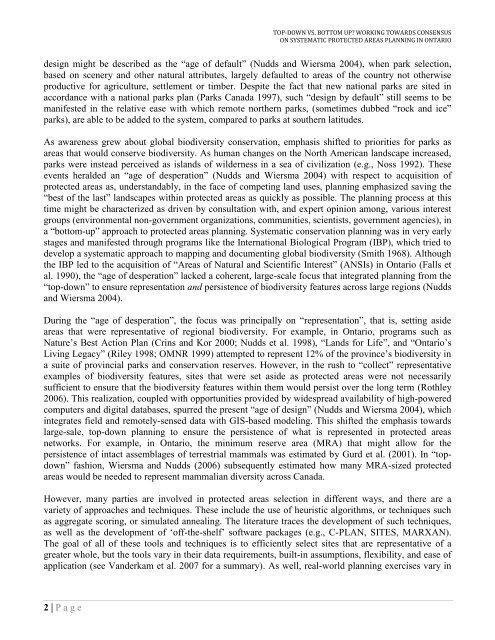Top-Down vs. Bottom Up: Working Towards Consensus ... - CASIOPA
Top-Down vs. Bottom Up: Working Towards Consensus ... - CASIOPA
Top-Down vs. Bottom Up: Working Towards Consensus ... - CASIOPA
- No tags were found...
Create successful ePaper yourself
Turn your PDF publications into a flip-book with our unique Google optimized e-Paper software.
TOP-DOWN VS. BOTTOM UP? WORKING TOWARDS CONSENSUSON SYSTEMATIC PROTECTED AREAS PLANNING IN ONTARIOdesign might be described as the “age of default” (Nudds and Wiersma 2004), when park selection,based on scenery and other natural attributes, largely defaulted to areas of the country not otherwiseproductive for agriculture, settlement or timber. Despite the fact that new national parks are sited inaccordance with a national parks plan (Parks Canada 1997), such “design by default” still seems to bemanifested in the relative ease with which remote northern parks, (sometimes dubbed “rock and ice”parks), are able to be added to the system, compared to parks at southern latitudes.As awareness grew about global biodiversity conservation, emphasis shifted to priorities for parks asareas that would conserve biodiversity. As human changes on the North American landscape increased,parks were instead perceived as islands of wilderness in a sea of civilization (e.g., Noss 1992). Theseevents heralded an “age of desperation” (Nudds and Wiersma 2004) with respect to acquisition ofprotected areas as, understandably, in the face of competing land uses, planning emphasized saving the“best of the last” landscapes within protected areas as quickly as possible. The planning process at thistime might be characterized as driven by consultation with, and expert opinion among, various interestgroups (environmental non-government organizations, communities, scientists, government agencies), ina “bottom-up” approach to protected areas planning. Systematic conservation planning was in very earlystages and manifested through programs like the International Biological Program (IBP), which tried todevelop a systematic approach to mapping and documenting global biodiversity (Smith 1968). Althoughthe IBP led to the acquisition of “Areas of Natural and Scientific Interest” (ANSIs) in Ontario (Falls etal. 1990), the “age of desperation” lacked a coherent, large-scale focus that integrated planning from the“top-down” to ensure representation and persistence of biodiversity features across large regions (Nuddsand Wiersma 2004).During the “age of desperation”, the focus was principally on “representation”, that is, setting asideareas that were representative of regional biodiversity. For example, in Ontario, programs such asNature‟s Best Action Plan (Crins and Kor 2000; Nudds et al. 1998), “Lands for Life”, and “Ontario‟sLiving Legacy” (Riley 1998; OMNR 1999) attempted to represent 12% of the province‟s biodiversity ina suite of provincial parks and conservation reserves. However, in the rush to “collect” representativeexamples of biodiversity features, sites that were set aside as protected areas were not necessarilysufficient to ensure that the biodiversity features within them would persist over the long term (Rothley2006). This realization, coupled with opportunities provided by widespread availability of high-poweredcomputers and digital databases, spurred the present “age of design” (Nudds and Wiersma 2004), whichintegrates field and remotely-sensed data with GIS-based modeling. This shifted the emphasis towardslarge-sale, top-down planning to ensure the persistence of what is represented in protected areasnetworks. For example, in Ontario, the minimum reserve area (MRA) that might allow for thepersistence of intact assemblages of terrestrial mammals was estimated by Gurd et al. (2001). In “topdown”fashion, Wiersma and Nudds (2006) subsequently estimated how many MRA-sized protectedareas would be needed to represent mammalian diversity across Canada.However, many parties are involved in protected areas selection in different ways, and there are avariety of approaches and techniques. These include the use of heuristic algorithms, or techniques suchas aggregate scoring, or simulated annealing. The literature traces the development of such techniques,as well as the development of „off-the-shelf‟ software packages (e.g., C-PLAN, SITES, MARXAN).The goal of all of these tools and techniques is to efficiently select sites that are representative of agreater whole, but the tools vary in their data requirements, built-in assumptions, flexibility, and ease ofapplication (see Vanderkam et al. 2007 for a summary). As well, real-world planning exercises vary in2 | P a g e


